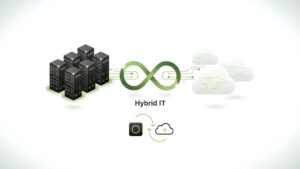Most business owners hear the cloud vs. on-premises debate as if it’s a cage match where only one side walks out. It isn’t. The sharpest operators have already stopped choosing sides. They run both—by design, not by accident—because “both” keeps the money flowing, people working, and risk contained without drama.
The Problem with “All-In” Thinking
Picking one side of Hybrid IT feels nice and tidy. But in real life, it isn’t that easy.
Go all-cloud, and everyday hiccups ripple through the whole shop. A brief internet slowdown, and now the warehouse can’t pull orders because the ERP lives online. Your phones also depend on that same connection, so support calls start stacking up. Vendor outage on their end? Now you’re staring at a spinner on their status page. Now add in the slow creep—per-user fees, storage add-ons, data egress—costs that seem small until you’re down the road a bit.
Go all-on-prem and you inherit a different kind of fragility. A snow day knocks power or access for a couple of hours and work stops for anyone not in the building. Remote staff fight a congested VPN to open a single file. A drive fails late Friday and you’re hunting parts instead of closing the week. Backups exist, but they’re in the same room as the server you’re trying to recover—great until the room is the problem.
Both models work—until an ordinary, boring failure hits. Push too far in either direction and you’re likely swapping one failure mode for another: convenience for control, or control for convenience. It looks clean on a slide; but it’s messy on Tuesday at 10:17 a.m. when people need to get work done.
Hybrid Isn’t a Compromise—It’s a Strategy
Hybrid IT is a path that some people skip because it sounds like a middle ground. It’s not a mushy average. It’s a purposeful architecture that puts each workload where it performs best. Keep the crown jewels—core line-of-business apps, latency-sensitive databases, and regulated data—close, fast, and under policies you control.
Push collaborative work, backup, email, CRM, and burst capacity into the cloud, where elasticity and anywhere-access are the whole point. You aren’t blending to be polite; you’re positioning assets for speed, resilience, and clarity. Best practices normally dictate an onsite Server for authentication, central file-printer-security management, the application specific cloud Vendors.
The Real-World Edge with Hybrid IT
Here’s how hybrid IT quietly wins:
- Resilience. Internet died? Folks on-site continue to work off the local stack. Server throwing a fit? Email, chat, and synchronized docs keep rolling in the cloud. No all-hands pause, no drama.
- Costs that behave. Buy the horsepower you use every day. Rent the surge if needed. Skip idle racks and the graveyard of “just-in-case” licenses.
- Speed where it matters. The click-wait-sigh loop disappears. Databases that need to be closed stay closed; shared work lives where your people are—online—so nobody’s stuck staring at a spinner.
- Compliance without contortions. Sensitive records stay inside your fence. Logins get MFA, logs are clean, and when an auditor says “show me,” you’ve got receipts.
- Continuity you can prove. Backups live off-site, and the restore button isn’t theoretical—you’ve run it. Power blink, snow day, coffee in the rack… business keeps moving.
It’s best to use a “belt and suspenders” approach that doesn’t slow you down — it keeps your business standing upright when others fall apart.
Why the Best IT Feels Invisible
Hybrid IT setups, when managed correctly, don’t make headlines. They work. They hum in the background, adjusting automatically, scaling quietly, keeping employees online and data safe.
When a company’s IT is invisible, that’s not a lack of innovation — it’s the highest compliment. It means your systems are so well-tuned that no one’s talking about them.
Bringing It Together
At Cycrest Systems, we don’t sell exclusively “cloud” or “on-prem.” We design what makes sense — the right blend of both, tailored to how you actually work. Because the future of IT isn’t about picking a side, it’s about not having to.
If you’re considering a new hybrid IT approach for your operations, you’ve come to the right place. Please call 509-747-9275 to schedule a free consultation with Cycrest.



